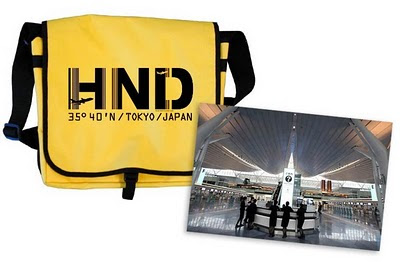
To help celebrate Japan's launching of Haneda (HND) airport, we are launching Haneda airport Air Wear travel bags, t-shirts, and more - click here.
From the Wall St. Journal
BUSINESSOCTOBER 20, 2010
Japan Offers Long-Awaited Alternative to Narita
By MARIKO SANCHANTA
TOKYO—Narita International Airport has long been the scourge of frequent fliers and business travelers because of its distance from Japan's capital, but now Tokyo is offering an alternative after decades of delay.
On Thursday, Haneda Airport—a mere 20 minutes from downtown Tokyo—is set to open its doors to scheduled international flights and increase its capacity by 40%, in a move that analysts have called the "big bang" in aviation liberalization in Japan.
Despite Japan's reputation for efficient infrastructure, the country has lagged behind its Asian peers when it comes to its main international airport, which is located among rice paddies about 90 minutes from central Tokyo.
Traditional Japanese tea lounge is seen inside the new international terminal building of Haneda Airport in Tokyo, Japan. The terminal is due to open on Oct. 21.
"If Narita disappeared, I wouldn't mind," said Hiromichi Shirakawa, an economist at Credit Suisse in Tokyo who travels abroad six or seven times a year. "Access to Haneda is so much easier. Think of the opportunity cost of travel time: it takes over an hour [to go to Narita], versus 15 minutes" to reach Haneda, he added.
Haneda, which had been operating just a handful of international charter flights to Asian destinations such as Beijing and Hong Kong, plans to unveil its new international terminal Thursday. The introduction of scheduled international service will be staggered from Oct. 31, and by next spring, passengers will be able to fly from Haneda to Paris, Honolulu, Los Angeles, New York, Singapore and Bangkok, among other destinations.
The new runway will create an additional 110,000 landing slots a year, 60,000 of which will be used for international flights. By 2013, the government aims to increase international slots to 90,000.
Japan has consistently been left off the top-10 international-airports list, which is dominated by Asian gateways. In 2010, Changi Airport in Singapore, Incheon International Airport in South Korea and Hong Kong International Airport were the top three airports in the world respectively, according to the Skytrax World Airport Awards.
Part of the impetus to expand Haneda was to raise Japan's competitiveness against its Asian peers, particularly as low-cost carriers in the region are flourishing. Because of regulations, Japan has the highest landing fees in the world: It costs 770,000 yen, or about $9,400, to land a Boeing 747-400 at Narita, compared with 70,000 yen at Heathrow Airport in London.
Members of the information desk work in the departure lobby of the new international terminal building of Haneda Airport.
The government hopes the changes at Haneda will encourage more visitors to Japan, chiefly from Asia. It signaled a shift in policy when the Democratic Party of Japan came into power last year. Narita had been the brainchild of Japanese bureaucrats when it opened in 1978, and efforts to expand Haneda had, for years, been shelved because of the political controversy it would cause.
"Haneda will mark its first step toward becoming a 24-hour international hub," said Sumio Mabuchi, Japan's transport minister, in a speech last weekend.
Read full article
